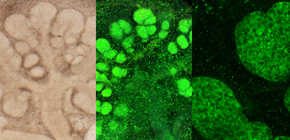
A mechanism for controlling the size of organs by melatonin clarified
Melatonin has also drawn attention in recent years as a rejuvenation hormone
A group of researchers led by SAKAI Takayoshi (Professor, Graduate School of Dentistry, Osaka University) found melatonin and melatonin receptors in salivary glands of mouse fetuses. Melatonin was thought to be produced by the pineal gland in the brain, but this group found that melatonin was also produced in salivary glands of mouse fetuses and controlled the size of the salivary glands via melatonin receptors expressed on the epithelial acinus. Melatonin has relatively little toxicity, so the clarification of a mechanism for controlling the size of organs by melatonin is thought to make a great contribution in regenerative medicine.
Furthermore, melatonin is known to be involved in the synchronization of circadian rhythm, helping us achieve a good night's sleep, and has antioxidant and osteoinductive properties as well as anticancer effects. In recent years melatonin has also drawn attention as a rejuvenation hormone and its application to a variety of fields is greatly sought after.
Abstract
Many organs, including salivary glands, lung, and kidney, are formed by epithelial branching during embryonic development. Branching morphogenesis occurs via either local outgrowths or the formation of clefts that subdivide epithelia into buds. This process is promoted by various factors, but the mechanism of branching morphogenesis is not fully understood. Here we have defined melatonin as a potential negative regulator or “brake” of branching morphogenesis, show that the levels of it and its receptors decline when branching morphogenesis begins, and identified the process that it regulates. Melatonin has various physiological functions, including circadian rhythm regulation, free-radical scavenging, and gonadal development. Furthermore, melatonin is present in saliva and may have an important physiological role in the oral cavity. In this study, we found that the melatonin receptor is highly expressed on the acinar epithelium of the embryonic submandibular gland. We also found that exogenous melatonin reduces salivary gland size and inhibits branching morphogenesis. We suggest that this inhibition does not depend on changes in either proliferation or apoptosis, but rather relates to changes in epithelial cell adhesion and morphology. In summary, we have demonstrated a novel function of melatonin in organ formation during embryonic development.
To learn more about this research, please view the full research report entitled " Melatonin inhibits embryonic salivary gland branching morphogenesis by regulating both epithelial cell adhesion and morphology " at this page of the PLOS ONE website.
Related Links

